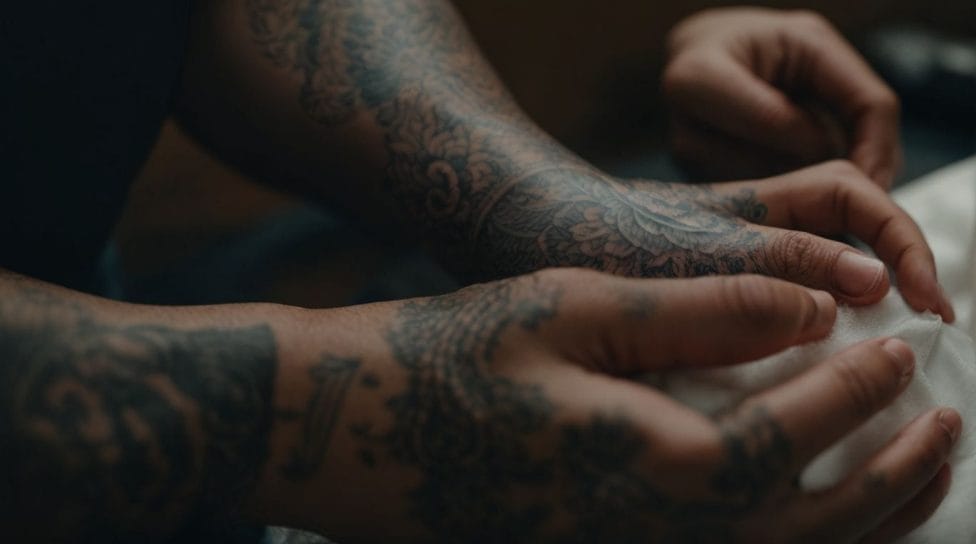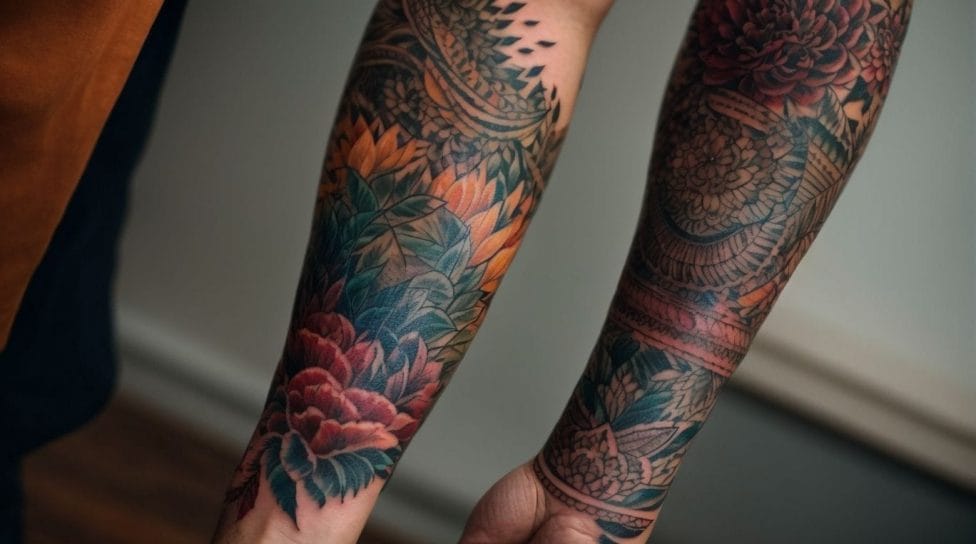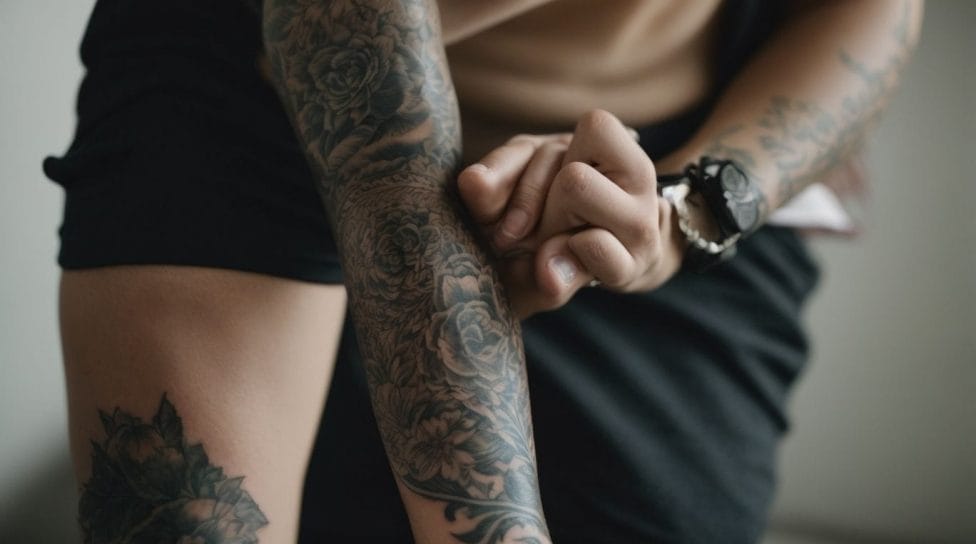Tattoos are a popular form of personal expression, but for many potential tattoo enthusiasts, the fear of pain can be a significant concern. When it comes to forearm tattoos, understanding the pain level involved is crucial for making an informed decision. In this article, we will explore the factors that affect tattoo pain, specifically focusing on forearm tattoos.
Tattoo pain is subjective and can vary significantly from person to person. It is generally described as a sensation of discomfort or pressure as the tattoo needle penetrates the skin. However, it is essential to note that everyone’s pain tolerance and perception varies, so what is painful for one person may be tolerable for another.
Several factors can influence the level of pain experienced during a tattoo session. Understanding these factors can give you an idea of what to expect before getting a forearm tattoo.
The placement of a tattoo plays a significant role in the level of discomfort experienced. Areas with thinner skin or closer to bones and nerve endings tend to be more sensitive. Forearm tattoos generally fall into a moderate pain category due to the presence of muscles and tendons, but the exact pain level can vary.
Individuals have different levels of skin sensitivity, which can impact their perception of pain during tattooing. Some people have more sensitive skin, making their tattoo experience more uncomfortable.
The size and complexity of a tattoo design can influence the duration of the tattooing process. Longer sessions can increase discomfort, especially with low pain tolerance.
The technique and skill of the tattoo artist can also contribute to the overall pain experienced. An experienced artist with a lighter hand may be able to minimize discomfort during the tattooing process.
Regarding forearm tattoos, several factors specific to this area can affect the pain level experienced.
The thickness of the skin on the forearm can vary from person to person. Thicker skin tends to provide more cushioning, potentially resulting in a less painful experience.
Forearm tattoos close to bones, such as the ulna or radius bones, can be slightly more uncomfortable due to the proximity to these bony structures.
The forearm contains numerous nerve endings, which can contribute to increased sensitivity and potential discomfort during tattooing.
While tattoo pain is inevitable to some extent, there are several strategies you can employ to minimize discomfort during a forearm tattoo session.
Topical numbing creams containing lidocaine can be applied to the skin before the tattooing process to reduce pain and discomfort.
Taking short breaks during a long tattoo session can help alleviate discomfort and allow you to rest.
Staying well-hydrated before and during the tattoo session can help keep your skin supple and reduce discomfort.
Engaging in relaxation techniques, deep breathing exercises, or listening to music can help divert your attention and manage pain perception.
There are several myths surrounding forearm tattoos and pain that need clarification.
While forearm tattoos can be uncomfortable, the pain levels vary depending on individual factors and tattoo placement.
Pain perception is not determined by gender. The level of discomfort experienced during a forearm tattoo is unique to each person.
The pain level can vary depending on individual factors, but there is no general rule that states upper forearm tattoos are more or less painful than lower forearm tattoos.
Here are some additional tips that can help manage pain during a forearm tattoo:
– Communicate your pain tolerance level with your tattoo artist.
– Take breaks if needed during a long session.
– Practice deep breathing techniques to relax your body and mind.
– Wear comfortable clothing that allows easy access to the tattooed area.
– Stay mentally and physically prepared by getting a good night’s sleep before you.
Key takeaways:
- Tattoo pain varies depending on placement, size, and the artist’s technique. Forearm tattoos may be less painful due to thicker skin and fewer nerve endings compared to other areas.
- Ways to minimize pain during a forearm tattoo include using topical anesthetic creams, taking breaks during the process, staying hydrated, and adjusting pain tolerance. These techniques can help make the experience more comfortable.
- There are common myths about forearm tattoos and pain, such as the belief that they are always extremely painful or more painful for women. However, pain perception is subjective, and individual experiences may vary.
Understanding Tattoo Pain

Photo Credits: Tattooineplanet.Com by Russell Thompson
Understanding tattoo pain is crucial before getting inked. While the level of pain tolerance may vary, it is generally believed that the forearm is one of the least painful areas for tattooing. Several factors contribute to the pain experienced, including individual sensitivity, the size and design of the tattoo, and the artist’s technique. There are a few ways to manage the pain during the tattooing process, such as taking deep breaths, focusing on the final result, or utilizing numbing creams. For instance, a friend of mine received a forearm tattoo and expressed the pain as a mild discomfort, similar to a cat scratch, making the overall experience quite bearable.
Factors Affecting Tattoo Pain

Photo Credits: Tattooineplanet.Com by Anthony Rodriguez
Curious about the pain level of forearm tattoos? Let’s dig into the factors that can influence tattoo pain. From tattoo placement and skin sensitivity to the size and complexity of the design, we’ll explore how these elements can affect your experience. Plus, we’ll uncover the impact of the artist’s technique on the level of discomfort you may feel. Get ready to uncover the secrets behind tattoo pain and make informed decisions for your next ink session!
Tattoo Placement
Tattoo placement is a crucial aspect to consider when considering a tattoo. Different parts of the body have varying levels of pain and discomfort during the tattooing process. The forearm is a popular choice for tattoos, renowned for offering a moderate pain level compared to more sensitive regions like the ribs or inner wrist. The outer forearm, in particular, tends to be less painful due to its thicker skin and fewer nerve endings. The pain level is also influenced by factors such as proximity to bones and the thickness of the skin. Ultimately, the pain experienced during a forearm tattoo can differ based on an individual’s pain tolerance and the technique employed by the artist.
Skin Sensitivity
Skin sensitivity is an important consideration when getting a tattoo on your forearm. The skin’s sensitivity in this particular area can differ from person to person. Some people may have highly sensitive skin, while others may have lower sensitivity. Various factors, including genetics, overall health, and previous skin conditions, can impact skin sensitivity. It is crucial to discuss your skin sensitivity with your tattoo artist before getting inked so that they can adjust their technique accordingly. By taking skin sensitivity into account, you can enhance the comfort of the tattooing process and minimize any potential discomfort.
I have a vivid memory of a friend who wished to have a forearm tattoo but had concerns about their sensitive skin. They sought advice from a reputable tattoo artist who took the time to comprehend their worries. The artist employed a delicate approach and thoroughly tested the skin’s sensitivity before proceeding. Consequently, my friend obtained their tattoo with minimal pain and irritation, all thanks to the artist’s understanding and adaptability to their skin sensitivity.
Tattoo Size and Complexity
The size and complexity of a tattoo are crucial factors to consider when deciding to get inked. When it comes to larger tattoos, like full sleeves or back pieces, they demand more time and effort to finish, which may result in increased discomfort and pain. Tattoos with intricate details and shading also contribute to heightened discomfort during the tattooing process. However, individuals’ pain tolerance varies, making it subjective. Something painful for one person might be bearable for another. If pain concerns you, it is advisable to start with smaller and less complex tattoos. Additionally, consulting with a skilled tattoo artist can assist in assessing the level of discomfort based on the chosen design.
Artist’s Technique
When obtaining a tattoo, the technique employed by the artist plays a vital role in determining the overall experience. An artist who is experienced and skilled will utilize proper techniques to minimize pain and ensure a successful outcome. They will possess a steady hand, execute precise movements, and possess knowledge of various needle configurations. Additionally, proficient artists comprehend how to adjust the speed and pressure of tattooing based on the client’s pain tolerance and the specific area being tattooed. By prioritizing the artist’s technique, you can guarantee a more comfortable and satisfying tattooing experience.
Similarly, I once had the opportunity to receive a forearm tattoo from a renowned artist recognized for their exceptional technique. Their delicate touch and meticulous attention to detail made the process remarkably painless. They comprehended the ideal equilibrium between speed and pressure, crafting a masterpiece without causing unnecessary discomfort. It served as a true testament to the significance of an artist’s technique in enhancing the overall tattoo experience.
Pain Level of Forearm Tattoos

Photo Credits: Tattooineplanet.Com by Samuel Moore
Curious about the pain level of forearm tattoos? Let’s dive into it! In this section, we’ll explore three key factors that influence the level of discomfort: skin thickness, proximity to bones, and nerve endings in the forearm. Prepare to uncover fascinating insights about how these elements can impact the experience of getting a tattoo on your forearm. So, if you’re contemplating this inked journey, stay tuned!
Skin Thickness
Skin thickness plays a crucial role in determining the level of pain associated with getting a forearm tattoo. The process of tattooing is generally less painful when the skin is thicker. Comparatively, the skin on the forearm is typically thicker than other parts of the body, such as the wrist or inner elbow. The thickness of the forearm skin provides better protection and cushioning against the tattoo needle, resulting in a reduced level of pain. However, it is important to note that pain perception varies from person to person. Individual pain tolerance and the specific tattooing technique the artist employs also influence the pain experienced during the process.
Proximity to Bones
The pain level experienced during the tattooing process can be influenced by the proximity of a forearm tattoo to bones. When a tattoo is placed closer to the bones in the forearm, individuals may experience more discomfort due to the area’s sensitivity. This is because the bones in the forearm are closer to the surface, causing the tattoo needle to have more direct contact with them. As a result, the sensation can be sharper and more intense. However, it is important to remember that pain tolerance varies from person to person, so some individuals may find the pain to be more manageable. To help minimize discomfort, proper pain management techniques can be employed, such as using topical anesthetics or taking breaks during the tattooing process.
Nerve Endings in the Forearm
The forearm is an area of the body that contains a high concentration of nerve endings, which makes it particularly sensitive to pain during the tattooing process. These nerve endings transmit pain signals to the brain, resulting in discomfort. Factors such as the thinness of the skin in this area and its proximity to bones can further enhance the pain sensitivity. However, it’s important to note that pain tolerance can vary from person to person. Several techniques can help manage the pain, such as taking breaks, using topical anesthetics, and selecting a skilled artist. By employing these methods, the pain experienced during a forearm tattoo can be effectively minimized. Interestingly, it is estimated that the forearm contains approximately 27,000 nerve endings per square inch, highlighting the high concentration in this area.
Ways to Minimize Pain

Photo Credits: Tattooineplanet.Com by Logan Hill
Are you looking to minimize the pain of tattooing on your forearm? We’ve got you covered! In this section, we’ll explore various strategies that can help make the tattooing process a little less uncomfortable. From topical anesthetic creams to taking breaks during the session, maintaining hydration, and even adjusting your pain tolerance, we’ll provide you with valuable insights to make your tattooing experience as painless as possible. So, let’s dive in and discover these pain-reducing techniques!
Topical Anesthetic Creams
“Using Topical Anesthetic Creams for a More Comfortable Forearm Tattoo Experience
When getting a forearm tattoo, the pain can be a major concern. Fortunately, there is a solution – topical anesthetic creams. These creams are designed to minimize the discomfort during the tattooing process, making it a more bearable and enjoyable experience.
Key Points about Topical Anesthetic Creams
- Application: Before your tattoo session, it is important to apply the cream to the area where the tattoo will be placed. Always follow the instructions provided by the manufacturer for proper application.
- Numbing Effect: The active ingredients, such as lidocaine or benzocaine, in these creams work wonders by effectively numbing the skin and blocking the nerves’ signals. This reduces the sensation of pain, ensuring a more comfortable tattooing process.
- Duration: It is worth noting that the duration of the numbing effect may vary depending on the specific cream used. Some creams can provide relief for a few hours, allowing for a longer and more pleasant tattoo experience.
- Consultation with the Artist: Communication is key. It is essential to inform your tattoo artist about your intention to use a topical anesthetic cream. They can offer guidance on the proper application process and ensure it does not interfere with their tattooing technique.
By incorporating topical anesthetic creams into your forearm tattoo session, you can significantly reduce the associated pain, enhancing the overall experience. So, don’t let the fear of discomfort hold you back – try using these creams and make your tattoo adventure a breeze!
“
Taking Breaks During the Tattooing Process
Taking breaks during the tattooing process is crucial for managing pain and discomfort. To effectively incorporate breaks, consider the following steps:
1. Plan breaks in advance: Before the tattoo session, discuss with your tattoo artist the possibility of taking breaks during the longer sessions.
2. Set a time limit: Determine the duration of each break, ensuring it allows enough time for rest.
3. Communicate with your artist: Inform your tattoo artist when you need a break. This will let them pause the tattooing process and give you the necessary time.
4. Find a comfortable position: Utilize the break time to adjust your position and alleviate tension or discomfort.
5. Stretch and move around: Take advantage of the break to stretch your limbs and gently move, which can help prevent stiffness.
6. Stay hydrated: It is important to drink water during breaks to stay hydrated and maintain your energy levels.
7. Manage pain: During the break, consider applying topical numbing creams or taking pain relievers, if needed, to help alleviate any discomfort.
8. Stay calm and relaxed: Utilize relaxation techniques such as deep breathing or visualization during the tattooing process, as they may assist in reducing anxiety and perception of pain.
Maintaining Proper Hydration
Maintaining proper hydration is essential during the tattooing process to reduce pain and facilitate optimal healing. Here are some steps to ensure you remain hydrated:
- Before your tattoo appointment, make sure to drink an ample amount of water to start well-hydrated.
- During breaks in the tattooing process, it’s beneficial to have a water bottle handy to sip on.
- Avoid consuming caffeine or alcohol, as they can dehydrate your body.
- Consider bringing drinks or snacks rich in electrolytes to replenish lost minerals and nutrients.
- Keep hydrating even after the tattoo session to support the healing process and minimize discomfort.
By maintaining proper hydration, you can help alleviate the pain associated with getting a forearm tattoo and promote faster healing.
Adjusting Pain Tolerance
Adjusting pain tolerance is crucial when it comes to getting a forearm tattoo. Here are several steps that can assist you in effectively managing the pain:
- Mentally prepare yourself by maintaining a positive mindset and focusing on the outcome.
- Thoroughly research the artist’s technique and opt for someone with extensive experience and exceptional skills.
- Incorporate pain management techniques such as engaging in deep breathing exercises or practicing meditation throughout the tattooing process.
- Take into consideration the utilization of topical anesthetics to numb the specific area before undergoing the tattoo procedure.
- Openly discuss pain management alternatives with your chosen tattoo artist to guarantee a comfortable and pleasant experience.
Debunking Common Myths about Forearm Tattoos and Pain

Photo Credits: Tattooineplanet.Com by Thomas Miller
Curious about forearm tattoos and the pain that comes with them? Let’s debunk some common myths surrounding this topic. We’ll explore whether forearm tattoos are always incredibly painful, whether the pain differs between genders, and whether the location of the tattoo on the forearm affects the level of discomfort. Prepare to have your assumptions challenged and discover the truth about the pain associated with forearm tattoos.
Myth: Forearm Tattoos Are Always Extremely Painful
There is a common misconception that forearm tattoos are always extremely painful, but this is not necessarily true. While tattoos can cause discomfort, the pain level varies from person to person. Factors such as individual pain tolerance, the size and complexity of the tattoo, and the artist’s technique can all affect the level of pain experienced. The location of the tattoo on the forearm can also play a role in the level of discomfort. It is important to remember that everyone’s pain threshold is different, and what may be extremely painful for one person may not be as intense for another.
Myth: Forearm Tattoos Are Less Painful for Men than for Women
Contrary to the myth that forearm tattoos are less painful for men than for women, there is no significant difference in the pain experienced. The level of pain felt during a tattoo is dependent on various factors, including individual pain tolerance, the skill of the artist, and the location of the forearm. Pain perception is subjective and can vary from person to person. It is important to note that pain is a personal experience and cannot be generalized solely based on gender. To manage discomfort, it is recommended to mentally prepare, choose a skilled artist, consider the tattoo location, and, if necessary, use topical anesthetics.
Myth: Upper Forearm Tattoos Are More Painful than Lower Forearm Tattoos
The belief that upper forearm tattoos are more painful than lower forearm tattoos is a common myth that lacks factual evidence. The experience of pain during a tattoo varies from person to person and is subjective. Pain levels are determined by factors such as individual pain tolerance, skin sensitivity, and the technique used by the artist. The upper and lower forearm areas contain a similar density of nerve endings, resulting in relatively equal pain distribution. It is important to debunk such myths to empower individuals to make well-informed decisions about their tattoo placement based on personal preferences rather than unfounded beliefs.
Tips for Pain Management During a Forearm Tattoo

Photo Credits: Tattooineplanet.Com by Andrew Ramirez
When it comes to getting a forearm tattoo, there are several tips for pain management that you can incorporate. These techniques can help you endure the process with minimal discomfort:
- One important tip is to choose the right artist. It is crucial to thoroughly research and select an experienced artist known for their gentle touch.
- Another tip is to stay hydrated. Drinking plenty of water before the appointment can help keep your skin hydrated, making the experience more bearable.
- Using numbing creams is also a helpful technique. Before the tattooing begins, apply a topical numbing cream to the area to minimize pain.
- Practicing deep breathing can help distract you from the pain. Focus on slow, deep breaths during the tattooing process.
- During longer tattoo sessions, don’t hesitate to ask for short breaks if needed. Taking breaks allows you to rest and recover, reducing the overall discomfort.
It’s important to remember that everyone’s pain tolerance is different, so it’s essential to experiment with these pain management tips to find what works best for you. Good luck with your forearm tattoo!
Some Facts About Do Tattoos on Forearm Hurt?
- ✅ Getting a tattoo on the forearm is less painful than other body parts. (Source: Our Team)
- ✅ Pain tolerance varies from person to person, so the pain level experienced during a forearm tattoo can differ. (Source: Our Team)
- ✅ Forearm tattoos have fewer nerve endings and more fat, which can contribute to a lower pain level. (Source: Our Team)
- ✅ Tattooing over bones, such as the inner forearm, may cause higher pain levels due to less fat and more nerve density. (Source: Our Team)
- ✅ The perception of pain during a forearm tattoo can be influenced by factors like the artist’s technique and the individual’s pain tolerance. (Source: Our Team)


